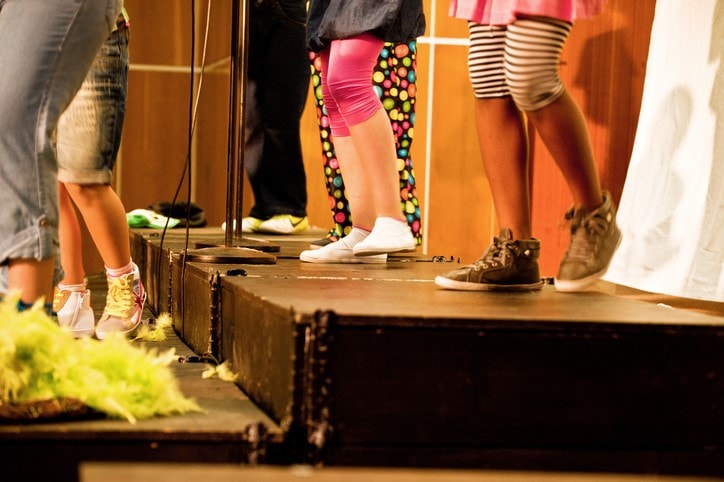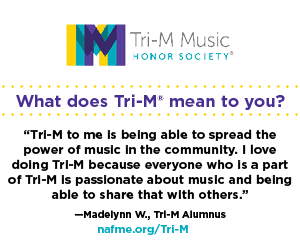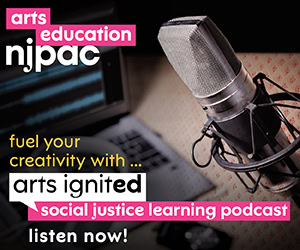/ News Posts / Recognize the Importance of Recruitment Presentations
Spring Forward
Recognize the Importance of Recruitment Presentations
By NAfME Member Lori Schwartz Reichl
This article was originally published in the April 2019 teacher edition of In Tune Magazine.
“The best way to predict the future is to create it.” ~ Abraham Lincoln
As final adjudications, performances, and trips for the school year near their end, we need to start thinking about how the next school year’s students and ensembles—with all their excitement and particular challenges—will help our music programs grow. Who will be the members in next year’s ensembles? What will the instrumentation or voice parts be? Where will the limitations be? What will we need to achieve for a balanced ensemble? What equipment and instruments may we need to obtain?
By this point in the school calendar, you may have already held auditions for next year’s ensembles and scheduled incoming students for their appropriate courses. But if you haven’t completed these tasks, or if you haven’t made contact with your incoming students, then consider a spring recruitment presentation. A high school director can create a presentation for the middle school students about to enter high school; middle school directors can make a presentation for elementary school students.
Contact each of your feeder directors and coordinate days/times to meet with incoming students. You may even consider including the next rising grade, too, as inspiration for program growth. For instance, if the 5th grade students are about to enter middle school, consider presenting to both 4th and 5th graders—similarly with 7th and 8th graders preparing to enter high school. These meetings could be scheduled during a rehearsal or as an additional meeting time, with the approval of each school’s director and administration. These meetings could be intended for students only, or they could also include the parents, too.
Consider bringing your most advanced ensemble to perform, a chamber group to highlight musical independence, or a few individual students to perform elaborate solos. If this isn’t possible, show a video of one of your ensemble’s most recent performances. Ask your students to share what they enjoy most as performing members of the music program, as well as any concerns they may have had prior to commitment—and how they have overcome these concerns. Finally, ask them to describe the advantages of being a valued member of the program.
As part of this, create an informative, engaging PowerPoint presentation, one that includes:
- Name of school/program
- Director’s name and contact information
- Performing ensembles
- Vision of the program
- Components of the program
- Typical schedule of a performing member
- Opportunities for ensemble advancement
- Opportunities for audition or participation in county, region, state, national, or international ensembles
- Rehearsal description
- Uniform expectations
- Upcoming events and performances
- Photos and videos
Be sure to explain the similarities and differences between the students’ current program and your program. For instance, when recruiting younger students, explain the frequencies of rehearsals; how students will be required to bring materials and/or instruments to and from school each day; the amount of practice required at home; and the number of performances, adjudications, and trips. Also create a document mirroring the presentation, so that students can take the information home to share with their families.
Either prior to your visit or immediately after, ask the feeder school’s director to send a message to parents/guardians notifying them of this visit, one that introduces you and explains the intention of the visit. Let parents know that information will be coming home with students, and describe how parents can assist with a smooth transition to middle or high school, specifically regarding participation in the music program. Consider including a list of local summer music opportunities/camps, along with a list of recommended private instructors.
Make yourself visible in the community throughout the school year. Consider opportunities for collaboration with your feeder programs, such as:
- Offering a sectional on your primary instrument/voice part
- Observing/adjudicating a rehearsal
- Conducting a rehearsal
- Giving a clinic for an ensemble
- Creating a side-by-side concert
- Hosting a community showcase of music
- Hosting a marching band night
- Attending a performance of your feeder programs
- Assisting with a performance or trip
Don’t forget the importance of getting your ensemble out of the building to be seen, heard, and appreciated within the community. Very few people outside of your classroom will support your music program or recognize its worth unless you offer a demonstration. Perform as often as possible outside of the school building. These types of performances do not require a concert-like atmosphere; they can simply serve as inspiration. Ask the principal of your school or a feeder school, the superintendent, a community organizer, or the mayor if your ensemble can perform for an upcoming event. Perhaps your students can perform “The Star-Spangled Banner,” your school song, a prelude, or a processional.
One of my favorite performances each year, and that of my band members, is to travel to an elementary school with my most advanced ensemble dressed-up in costume to perform pep tunes at the school’s Halloween parade. I have conducted the band dressed as Big Bird, Pocahontas, and a handful of outlandish characters all for the sake of igniting excitement in future musicians. The younger students are in awe of the performance and the dedication of the older musicians, along with delighting in the various instruments and the colorful costumes. They often approach me or a band member to share with us which instrument they are learning or planning to play in the future. Never miss an opportunity to recruit.
Educators shouldn’t wait for students to walk in the door of a music room. Get out in the community, collaborate with your feeder schools’ directors, connect with future students, create opportunities for engagement, and invite students to join your program—entice and excite them!
About the author:
NAfME member Lori Schwartz Reichl is an author, educator, and consultant. Visit her at MakingKeyChanges.com.
Join Lori for a week-long graduate course reflecting the ideas shared each month in this column: AMUS 605: Making Key Changes: Refresh Your Music Program, 3 credits, July 20–24, 2020, through the University of the Arts at the Villanova University location in Pennsylvania.
Did this blog spur new ideas for your music program? Share them on Amplify! Interested in reprinting this article? Please review the reprint guidelines.
The National Association for Music Education (NAfME) provides a number of forums for the sharing of information and opinion, including blogs and postings on our website, articles and columns in our magazines and journals, and postings to our Amplify member portal. Unless specifically noted, the views expressed in these media do not necessarily represent the policy or views of the Association, its officers, or its employees.
Published Date
March 9, 2020
Category
- Recruitment and Retention
Copyright
March 9, 2020. © National Association for Music Education (NAfME.org)







